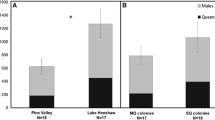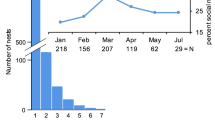Abstract
Ecological factors have been claimed paramount for the evolution and maintenance of cooperative group living in eusocial termites, as well as in cooperatively breeding birds and mammals. However, a clear demonstration of the role of any specific ecological factor in termites has been lacking. In the termite Cryptotermes secundus, individuals have two options, staying as helpers at the natal nest or developing into winged sexuals that disperse to found new colonies. An important ecological factor expected to influence the course of termite development is food availability; C. secundus nests inside a single piece of wood that serves as the sole source of food for the duration of the colony. As wood is consumed, the longevity of the colony is reduced, thus diminishing the potential fitness gains of staying at the nest. We experimentally investigated the occurrence of cooperative behavior and development under abundant- and limited-food conditions. Workers exposed to food-limited conditions were more likely to develop into dispersing sexuals and increased “selfishly” their food-acquisition behaviors. Proximately, a reduced frequency of proctodeal trophallaxis may have interfered with the distribution of pheromones that inhibit sexual development. Ultimately, decreased inclusive fitness benefits in food-limited, and thus short-lived nests, appear to explain the development of dispersing sexuals, supporting (1) the benefits-of-philopatry hypothesis as developed for the occurrence of cooperative breeding in vertebrates, and (2) predictions of reproductive skew theories.

Similar content being viewed by others
References
Abe T (1987) Evolution of life types in termites. In: Kawano S, Connell JH, Hidaka T (eds) Evolution and coadaptation in biotic communities. University of Tokyo Press, Tokyo, pp 125–148
Arnold KE, Owens IPF (1998) Cooperative breeding in birds: a comparative analysis of the life-history hypothesis. Proc R Soc Lond Ser B 265:739–745
Bartz SJ (1979) Evolution of eusociality in termites. Proc Natl Acad Sci USA 76:5764–5768
Beekman M, Komdeur J, Ratnieks FLW(2003) Reproductive conflict in social animals: who has power? Trends Ecol Evol 18:277–282
Bourke AFG, Ratnieks FLW (1999) Kin conflict over caste determination in social Hymenoptera. Behav Ecol Sociobiol 46:287–297
Crozier RH, Luykx PD (1985) The evolution of termite eusociality is unlikely to have been based on a haplodiploid analogy. Am Nat 126:867–869
Emlen ST (1997) Predicting family dynamics in social vertebrates. In: Krebs JR, Davies NB (eds) Behavioural ecology. Blackwell, Oxford, pp 228–353
Field J, Foster W, Shreeves G, Sumner S (1998) Ecological constraints on independent nesting in facultatively eusocial hover wasps. Proc R Soc Lond Ser B 265:973–977
Gadagkar R (1991) Demographic predisposition to the evolution of eusociality: a hierarchy of models. Proc Natl Acad Sci USA 88:10993–10997
Hamilton WD (1964) The genetic evolution of social behavior I, II. J Theor Biol 7:1–52
Hatchwell BJ, Komdeur J (2000) Ecological constraints, life history traits and the evolution of cooperative breeding. Anim Behav 59:1079–1086
Higashi M, Yamamura N, Abe T, Burns TP (1991) Why don’t all termite species have a sterile worker caste? Proc R Soc Lond Ser B 246:25–30
Husseneder C, Brandl R, Epplen JT, Kaib M (1999) Within colony relatedness in a termite species: genetic roads to eusociality? Behaviour 136:1045–1063
Johnstone RA (2000) Models of reproductive skew: A review and synthesis. Ethology 106:5–26
Keller L, Nonacs P (1993) The role of queen pheromones in social insects: queen control or queen signal? Anim Behav 45:787–794
Keller L, Reeve HK (1994) Partitioning of reproduction in animal societies. Trends Ecol Evol 9:98–102
Keller L, Reeve HK (1999) Dynamics of conflicts within insect societies. In: Keller L (ed) Levels of selection. Princeton University Press, Princeton, pp 153–175
Koenig WD, Pitelka FA, Carmen WJ, Mumme RL, Stanback MT (1992) The evolution of delayed dispersal in cooperative breeders. Q Rev Biol 67:111–150
Kokko H, Ekman J (2002) Delayed dispersal as a route to breeding: territorial inheritance, safe havens, and ecological constraints. Am Nat 160:468–484
Kokko H, Lundberg P (2001) Dispersal, migration, and offspring retention in saturated habitats. Am Nat 157:188–202
Korb J, Lenz M (2004) Reproductive decision-making in the termite Cryptotermes secundus (Kalotermitidae) under variable food conditions. Behav Ecol (in press)
Lacy RC (1980) The evolution of eusociality in termites: a haplodiploid analogy? Am Nat 116:449–451
Leinaas HP (1983) A haplodiploid analogy in the evolution of termite eusociality? reply to Lacy. Am Nat 121:302–304
Lenz M (1994) Food resources, colony growth and caste development in wood-feeding termites. In: Hunt JH, Nalepa CA (eds) Nourishment and evolution in insect societies. Westview, Boulder, pp 159–209
Lüscher M (1974) Kasten und Kastendifferenzierung bei niederen Termiten. In: Schmidt GH (ed) Sozialpolymorphismus bei Insekten. Wissenschaftliche Verlagsgesellschaft, Stuttgart, pp 694–739
Maynard Smith J (1964) Group selection and kin selection. Nature 201:1145–1147
Myles TG, Nutting WL (1988) Termite eusocial evolution: a re-examination of Bartz’s hypothesis and assumptions. Q Rev Biol 63:1–24
Nalepa CA (1994) Nourishment and the origin of termite eusociality. In: Hunt JH, Nalepa CA (eds) Nourishment and evolution in insect societies. Westview, Boulder, pp 57–104
Nutting WL (1969) Flight and colony foundation. In: Krishna K, Weesner FM (eds) Biology of termites. I. Academic, New York, pp 233–282
Pasteels JM, Roisin Y (2001) Primer pheromones in termites: state of the art. Proceedings of the Berlin Meeting of the European Section of IUSSI, p 102
Pen I, Weissing FJ (2000) Towards a unified theory of cooperative breeding: the role of ecology and life history re-examined. Proc R Soc Lond Ser B 267:2411–2418
Ratnieks FLW (2001) Heirs and spares: caste conflict and excess queen production in Melipona bees. Behav Ecol Sociobiol 50:467–473
Reeve HK, Emlen ST (2000) Reproductive skew and group size: an N-person staying incentive model. Behav Ecol 11:640–647
Reeve HK, Ratnieks FLW (1993) Queen-queen conflict in polygynous societies: mutual tolerance and reproductive skew. In: Keller L (ed) Queen number and sociality in insects. Oxford University Press, Oxford, pp 45–85
Roisin Y (1994) Intragroup conflicts and the evolution of sterile castes in termites. Am Nat 143:751–765
Roisin Y (1999) Philopatric reproduction, a prime mover in the evolution of termite sociality? Insectes Soc 46:297–305
Roisin Y (2000) Diversity and evolution of caste patterns. In: Abe T, Bignell DE, Higashi M (eds) Termites: evolution, sociality, symbioses, ecology. Kluwer, Dordrecht, pp 95–120
Sewell JJ (1978) Developmental pathways and colony organization in the genus Kalotermes Hagen (Isoptera: Kalotermitidae). PhD Thesis, Australian National University, Canberra
Sewell JJ, Watson JAL (1981) Developmental pathways in Australian species of Kalotermes Hagen (Isoptera). Sociobiology 6:243–323
Shellman-Reeve JS (1997) The spectrum of eusociality in termites. In: Choe JC, Crespi BJ (eds) The evolution of social behaviour in insects and arachnids. Cambridge University Press, Cambridge, pp 52–93
Springhetti A (1969) Il controllo sociale della differenziazione degli alati in Kalotermes flavicollis Fabr. (Isoptera). Ann Univ Ferrara Sez III Biol Anim 3:73–96
Stacey PB, Ligon JD (1991) The benefits of philopatry hypothesis for the evolution of cooperative breeding: variation in territory quality and group size. Am Nat 137:831–846
Stuart A (1979) The determination and regulation of the neotenic reproductive caste in the lower termites (Isoptera): with special reference to the genus Zootermopsis (Hagen). Sociobiology 4:223–237
Thorne BL (1997) Evolution of eusociality in termites. Annu Rev Ecol Syst 28:27–54
Trivers RL (1974) Parent-offspring conflict. Am Zool 14:249–264
Vehrencamp SL (1983) A model for the evolution of despotic versus egalitarian societies. Anim Behav 23:327–335
Watson JAL, Sewell JJ (1985) Caste development in Mastotermes and Kalotermes: which is primitive? In: Watson JAL, Okot-Kotber BM, Noirot C (eds) Caste differentiation in social insects. Pergamon, Oxford, pp 27–40
Acknowledgements
We wish to thank K. Schneider for help with data collection, D. Aanen, A. Hartmann, J. Heinze, H. Kokko, M. Lenz, and Y. Roisin for discussions on the manuscript, and C. Brent and M. Brandt for helpful comments and substantial improvement of our English. The project was supported by the German Science Foundation (Ko 1895/2-1). Environment Australia gave permission to export the termites (export permit no. PWS P20011508). The experiments performed comply with the current laws in Australia and Germany.
Author information
Authors and Affiliations
Corresponding author
Additional information
Communicated by L. Keller
Rights and permissions
About this article
Cite this article
Korb, J., Schmidinger, S. Help or disperse? Cooperation in termites influenced by food conditions. Behav Ecol Sociobiol 56, 89–95 (2004). https://doi.org/10.1007/s00265-004-0757-x
Received:
Revised:
Accepted:
Published:
Issue Date:
DOI: https://doi.org/10.1007/s00265-004-0757-x




